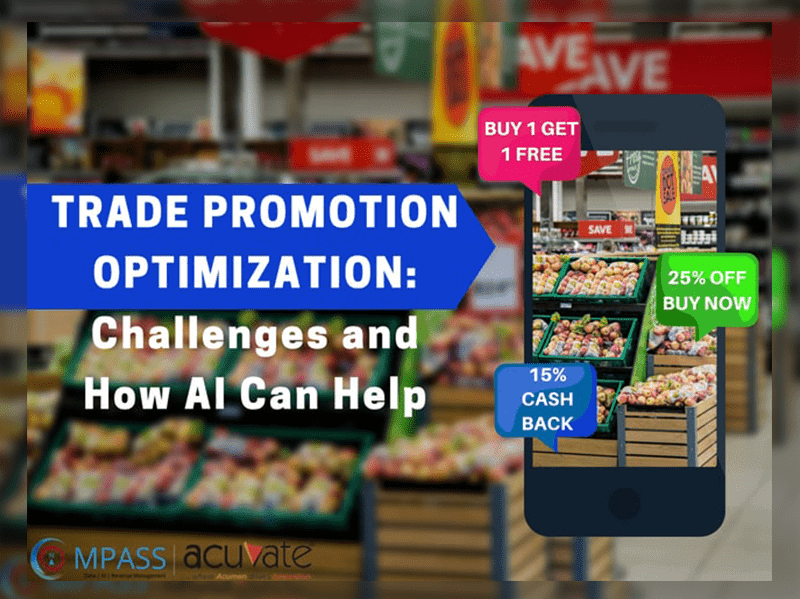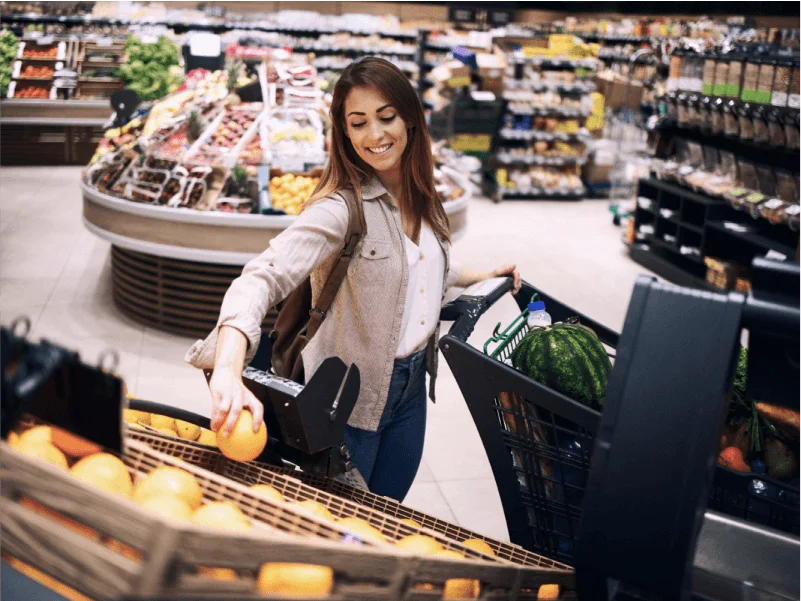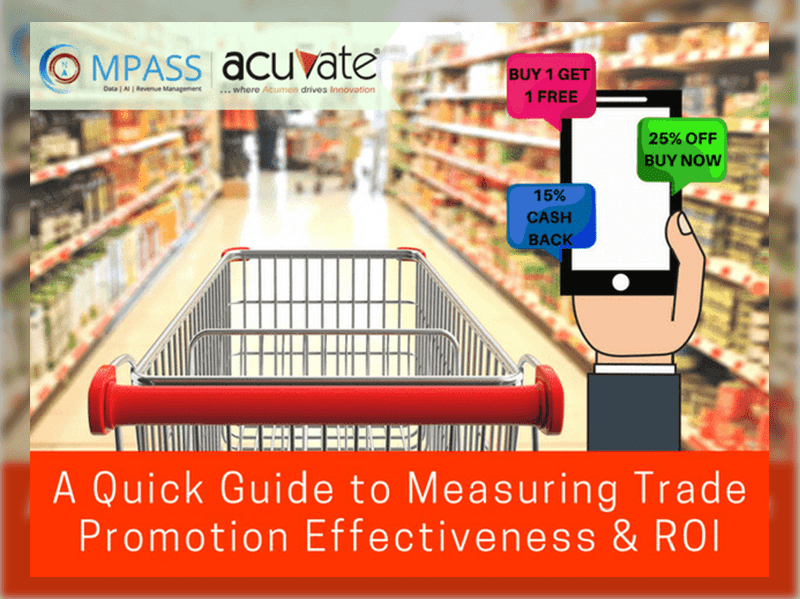40% of CPG trade promotion spending doesn’t drive the desired results – Nielsen Holdings
- What is the retailer performance in a location for a specific time period and for a specific product?
- BOGO vs Half price – what should I apply and where?
- What is the effectiveness of my past trade promotion? Will it work again for a different product or a scenario?
- How are my competitors optimizing their trade promotions, what does their promotion calendar look like?
- What are my predicted sales if I keep Brand A at the base price for the next 6 months and promote Brand B for a BOGO for the next 1 month?
These are just a handful of the hundreds of questions decision makers across the Consumer Goods industry( CPG) face on a day-to-day basis for optimizing their trade promotions. The truth of the matter is compared to that of other businesses, the 5Ps of marketing involved in the Consumer Goods industry is inconceivably diverse and complex. This makes a comprehensive 360-degree data-driven decision-making a virtually impossible task.
There is data available from a variety of sources – retailers, digital media, Nielsen and other data brokers, data from past promotions and so on. How much are you going to capture, harness and analyze in order to understand and optimize your trade promotions for the next quarter or year?
How do you choose the best combination for every product, area, and SKU in order to create promotions that are maximized for volume, sales, profit and a plethora of other important parameters within a given budget constraint?
How do you identify and run the promotion that gets the maximum bang for the buck?
Consumer goods manufacturers continue to spend a significant portion of their budgets managing promotions and price reductions as a part of collaborative efforts with retail partners. – Gartner
Trade Promotion Optimization In The Consumer Products Industry – Typical Scenario And Challenges
Data Availability Challenge
Most manufacturers typically depend on syndicated data brokers like Nielsen and IRI to devise promotion strategies. While this data is still essential, depending solely on this data will not provide a big picture view of reality.
Read More: Data Brokers: How Can Consumer Goods Companies Maximize ROI
Data Not In Proper Shape & Form
Decision-makers are either still depending on endless spreadsheets to understand promotional data or using substandard Trade Promotion Optimization analytics and software tools with shallow dashboards and insights. They are also forced to access data from multiple systems to get a comprehensive picture. All these practices complicate data consumption and are hard to incorporate into everyday workflows for decision-making.
High Dependence On Finding A Skilledcrew
Another infamous hurdle for accessing data and generating customized reports on a daily basis is the high dependence on IT Service or the MIS team. Business users can’t customize dashboards themselves and have to depend on these teams to get fresh reports or update old ones.
Missing/Difficult What-If Analysis
A lot of trade promotion strategy setting involves forecasting and accurately predicting “what is the impact if X happens” or “What will be the impact of my ROI and sales uplift if I run BOGO promotion for a cash cow.” However several trade promotional tools and software miss this type of in-depth analysis or provide generic analysis that does not deliver real business value.
New Plans Are Based on Gut or Partial Intelligence
Organizations are unable to measure the effectiveness of trade promotions due to lack of sufficient data, inefficient data harmonization, and predictive intelligence. As a result, there is a lack of data-backed optimization of upcoming trade promotions – either slight changes are made or nothing is done. Decision-makers resort to learnings from past experiences, instincts or partial intelligence.
Are Your Trade Promotions Generating The Desired ROI?
Compass: An AI-Powered Trade Promotion Optimization Solution
Ideal Trade Promotion Optimization Solution and The Role Of AI
An ideal trade promotion optimization software should be able to provide accurate granular insights and support a forward-thinking strategy with a predictive and prescriptive analysis. Here are some key elements that must be present in every trade promotion solution:
Takes Data From All Relevant Data Sources In The Right Format
The solution needs to be fed with raw data from multiple consumer and market touch points and data sources. This acts as a solid foundation for an analysis to be run and provides a holistic view of reality.
Some important sources include:
- Internal data: Market research, Past promotions, Primary sales, secondary sales, Marketing campaigns, POS etc.
- External data: Syndicated data, Social, Weather, TRP, Digital Analytics, Events, competitor campaigns etc.
The more sources considered, the higher the accuracy of your trade promotions strategy.
Easy To Use And Less Dependence On A High Skilled Crew
The Trade Promotion Optimization solution needs to be a self-service one, i.e, it should allow users to customize reports and filter dashboards by themselves, whenever they want, without having to depend on the IT department.
Ability To Learn, Measure and Optimize
Measuring trade promotion effectiveness is a tricky job for most consumer goods manufacturers. An ideal trade promotion software should be able to effectively harness the data from your past trade promotions, measure effectiveness and provide meaningful recommendations from the analysis. This in-depth and powerful analysis can be effectively performed only when the TPO software is integrated with AI technologies like machine learning, advanced analytics etc.

What-If Scenario And A Comparison Analysis
This is a critical area where the above mentioned AI technologies again come into play. AI supports a forward-thinking strategy and predicts outcomes for different actions. Say you wanted to know the outcome of promoting 3 brands for B2G1 and 2 other brands for a BOGO, the software should tell you what the expected ROI and sales uplift can be.
Measure & Optimize Your Trade Promotions Effectively
with Compass: An AI-Powered Trade Promotions Optimization Solution
You should also have the flexibility to change metrics and compare results in different scenarios with the Trade Promotion Optimization Software.

Acuvate’s Compass is one of the top AI-Powered Trade Promotion Optimization Solution which leverage advanced technologies like Big Data, Machine Learning, Advanced Analytics and Chatbots to help run high-yield trade promotions. Our customers include Unilever, Britvic, Reckitt Benckiser, Coca-Cola and many other CPG, Food and Beverage, Fashion and Apparel and Retail companies.
If you’d like to learn more about this topic, please feel free to get in touch with one of our experts for a personalized consultation.




